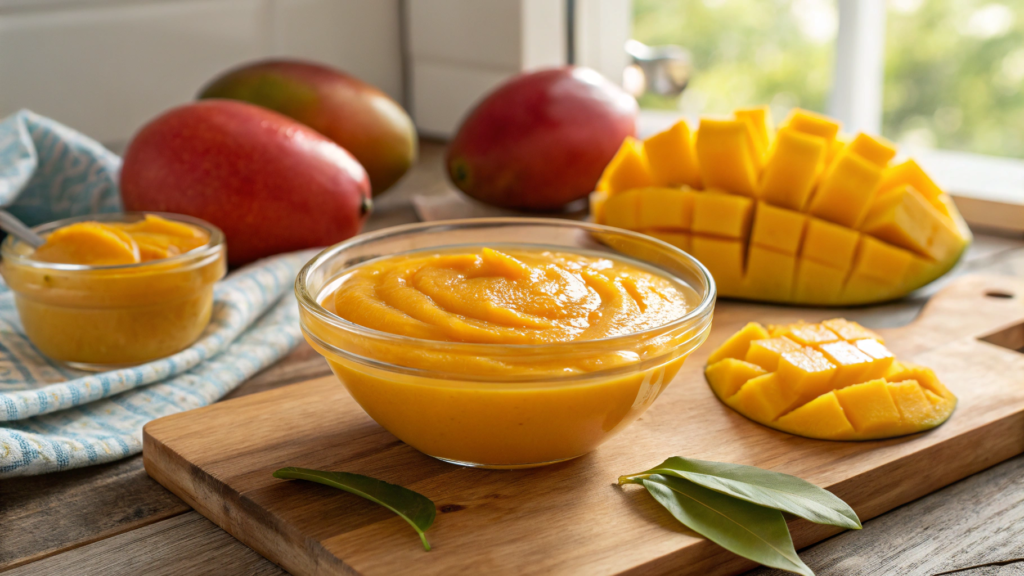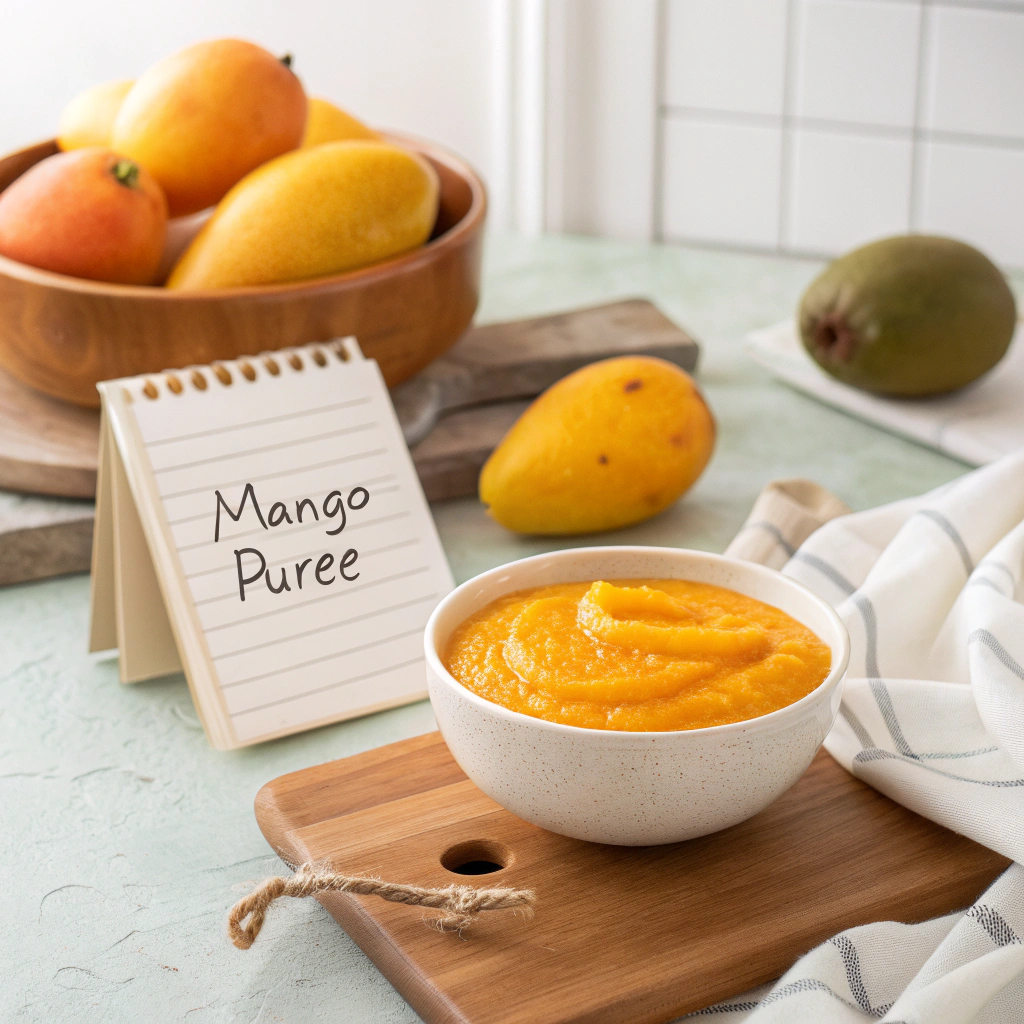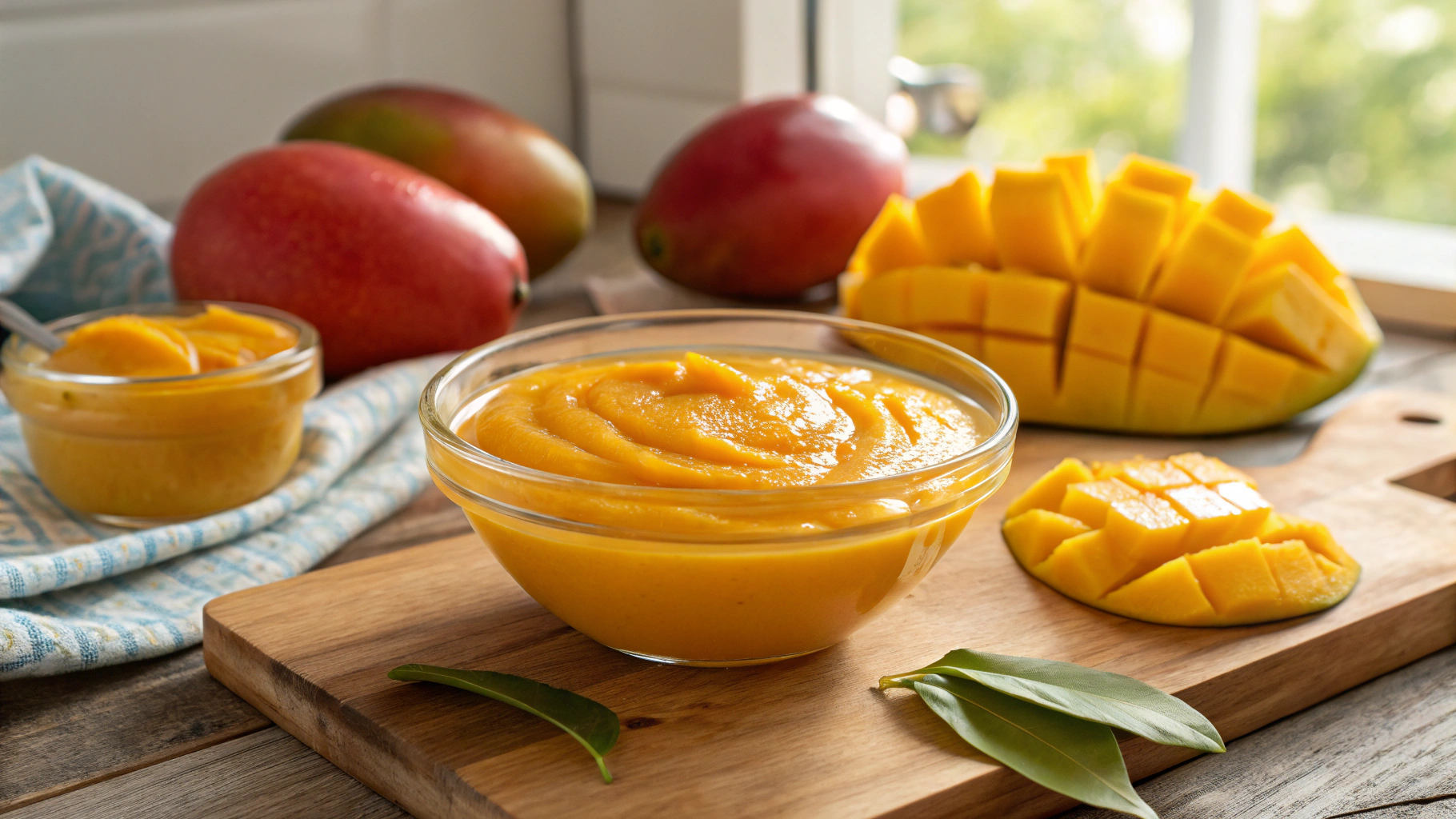There’s something unforgettable about the taste of fresh mango puree. Maybe it reminds you of sun-drenched afternoons, barefoot summers, or the sweet scent of your grandmother slicing ripe mangoes at the kitchen table. That golden, silky blend brings warmth to smoothies, desserts, and even savory dishes.
And the best part? You don’t need to be a chef or have fancy equipment to make it.
In this guide, you’ll learn exactly how to make mango puree at home step by step. It’s fast, fresh, and surprisingly simple. Whether you’re prepping food for your baby, making a tropical dessert, or stocking your freezer for future recipes, this mango puree recipe will become your go-to favorite.
Table of Contents
What is Mango Puree and Why Should You Make It at Home?
Mango puree is just what it sounds like a smooth blend of ripe mangoes. No sugar. No preservatives. Just pure tropical goodness.
Sure, you could buy canned puree at the store. But if you’ve tasted both, you already know: nothing compares to homemade. Store-bought versions are often loaded with additives or come from fruit that was picked too early. When you make it yourself, you’re in control of every bite.
Why Make Your Own Mango Puree?
- Freshness you can taste: The flavor of sun-ripened mangoes blended into a silky texture is unbeatable.
- Healthier: No hidden ingredients, preservatives, or sugar.
- Versatile: Use it in smoothies, baby food, marinades, desserts, or even cocktails.
- Saves money: Especially when mangoes are in season or on sale.
Choosing the Best Mangoes for Puree
Not all mangoes are created equal, especially when it comes to making a smooth, sweet puree. The right mango will make or break your recipe.
Best Mango Varieties for Puree:
- Ataulfo (Honey mango): Small, sweet, and buttery smooth.
- Alphonso: Popular in Indian recipes. Intensely fragrant and deep orange.
- Kent or Keitt: Larger, less fibrous, and great for a silky texture.
How to Pick the Perfect Mango:
- Touch: It should give slightly under gentle pressure—not rock-hard, not mushy.
- Smell: A ripe mango has a rich, fruity scent near the stem.
- Look: Avoid ones with large black spots or wrinkled skin.
Tip: If your mangoes aren’t ripe yet, let them sit at room temperature for a few days. Once ripe, store them in the fridge until you’re ready.

What You’ll Need (Tools & Ingredients)
You don’t need a high-tech kitchen setup to make this mango puree recipe. In fact, you likely have everything already.
Ingredients:
- 2–3 ripe mangoes
- Optional: lemon juice (to brighten the flavor), a splash of water (if needed for blending)
Tools:
- A sharp knife
- A cutting board
- A blender or food processor
- A fine mesh strainer (optional, for a smoother texture)
- An airtight jar or container for storage
Step-by-Step: How to Make Mango Puree at Home
Step 1 – Wash and Peel the Mangoes

Start by rinsing the mangoes under cool water to remove any dirt or pesticides. Use a vegetable peeler or a paring knife to gently peel the skin. Be careful mangoes can be slippery once peeled!
Step 2 – Cut Around the Pit
Place your mango upright on the cutting board. Using a sharp knife, slice vertically on both sides of the pit. Then cut off the smaller sides. Now you’ve got 2 large mango halves and two smaller pieces.
Slice the flesh into chunks for easier blending.
Step 3 – Blend the Mango
Add the mango pieces into a blender or food processor. Blend until you get a smooth, thick puree. If the mango is very fibrous, add a tablespoon of water at a time until it reaches your desired consistency.
Want it super silky? Pass the puree through a fine mesh strainer to remove any stringy bits.
Step 4 – Taste and Adjust
Try a spoonful. If it’s too tangy, you can balance it with a tiny bit of honey. If it’s too thick, a splash of lemon juice or coconut water can help thin it while boosting flavor.
Step 5 – Store Properly
Pour the puree into an airtight container. Store in the fridge for up to 3–4 days, or freeze in ice cube trays for up to 3 months.
How to Store Mango Puree the Right Way
Refrigeration:
- Use an airtight glass or BPA-free plastic container.
- Keep in the fridge for 3 to 4 days.
- Always use a clean spoon to avoid contamination.
Freezing:
- Portion mango puree into ice cube trays.
- Once frozen, transfer cubes to freezer bags or containers.
- Label with date. Use within 3 months for the best flavor.
Freezing small portions makes it super easy to use later—just toss a cube into smoothies, sauces, or baby food bowls.
Creative Ways to Use Mango Puree
Now that you’ve got a jar (or freezer full) of mango goodness, what should you do with it?
1. Smoothies & Drinks
- Blend with Greek yogurt and banana for a creamy tropical smoothie.
- Mix into lemonade or iced tea for a fruity twist.
- Add to cocktails like mango mojitos or margaritas.
2. Baby Food
- Serve it solo or mix with pureed banana, apple, or oatmeal.
- Ensure it’s free of added sugars and is extra smooth for younger babies.
3. Desserts
- Use as a topping for cheesecakes, pancakes, or waffles.
- Swirl into vanilla ice cream or yogurt parfaits.
- Add to cake batter or muffin mix for a fruity upgrade.
4. Sauces & Marinades
- Combine with lime juice, chili, and garlic for a mango glaze.
- Perfect for grilled shrimp, chicken, or tofu.
Nutritional Benefits of Mango Puree
Mango puree isn’t just delicious—it’s a health booster too.
Rich in Nutrients:
- Vitamin C: Strengthens immunity and promotes glowing skin.
- Vitamin A: Supports eye health and bone growth.
- Fiber: Aids digestion and helps you feel full.
- Antioxidants: May help protect against inflammation and free radicals.
If you’re making mango puree for your baby, rest assured—it’s one of the best fruit purees to start with because of its creamy texture and gentle taste.
Conclusion: Your New Favorite Tropical Staple
There you have it—your complete guide to making fresh, flavorful mango puree at home. No mystery ingredients. No complicated steps. Just ripe mangoes and a blender, and you’ve got the foundation for countless delicious recipes.
Now that you know the process, you can whip up mango puree whenever the craving hits—whether you’re making a summer dessert, prepping baby food, or planning your weekly smoothie prep.
So next time you spot ripe mangoes at the store or farmers market, grab a few. Your tastebuds (and your family) will thank you.
Frequently Asked Questions (FAQs) About Mango Puree Recipe
How long does homemade mango puree last?
It lasts 3 to 4 days in the fridge and up to 3 months in the freezer. Always use clean utensils and airtight containers to keep it fresh.
Can I use canned mangoes instead of fresh?
Yes, but check the label for added sugars or preservatives. Fresh mangoes will give you the purest flavor and highest nutrient content.
Can I make mango puree without a blender?
Absolutely. If your mangoes are super ripe, you can mash them with a fork or potato masher. It won’t be as smooth, but it’ll still work.
Is mango puree good for babies?
Definitely! Just make sure it’s smooth, free of sugar, and served in small amounts. It’s a great first fruit puree for babies around 6 months old.
What can I add to mango puree for extra flavor?
Try adding a splash of lemon juice, a bit of coconut milk, or a pinch of cinnamon for a unique twist.
How do you make mango puree?
Transfer mango pieces and sugar into the blender jar of a blender or a mixer grinder. Blend until smooth puree. Add 1/3 cup water or 5-6 ice cubes and blend again for 1-2 minutes. Transfer it to the serving bowl and garnish with cashew nuts.
If you found this mango puree recipe guide helpful, don’t forget to bookmark it or share it with your foodie friends. Want more fruity recipes? Keep an eye on our blog for tropical twists and wholesome creations made right in your kitchen.

